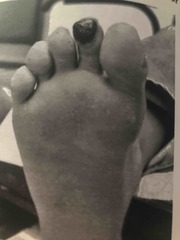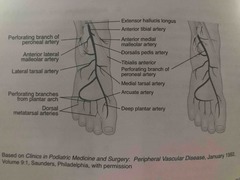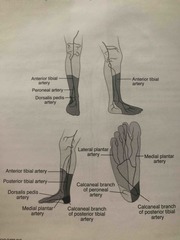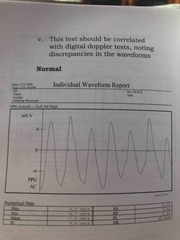![]()
![]()
![]()
Use LEFT and RIGHT arrow keys to navigate between flashcards;
Use UP and DOWN arrow keys to flip the card;
H to show hint;
A reads text to speech;
34 Cards in this Set
- Front
- Back
- 3rd side (hint)
|
ASO |
Arteriosclerosis Obliterans |
|
|
|
What’s the primary cause of occlusive disease |
ASO- arteriosclerosis obliterans Main lesion is atherosclerotic plaque |
|
|
|
Symptoms of ASO |
Intermittent claudication Nocturnal cramping Ischemic neuropathy Rest pain Cold intolerance |
|
|
|
ASO CLINICAL EXAM |
Onion skin, lack hair, nail / skin changes (pallor, rubor, cyanosis) Decreased pulses, cool skin, decreased turgor, delayed CFT |
|
|
|
Risk factors for ASO |
DM, HTN, smoking, high triglycerides, angina, MI, valvular heart dz, A-fib, stroke, prior LE revasc +/- stenting |
|
|
|
What’s the usual source of an arterial emboli?? |
The heart is the source of an arterial emboli 90% of the time |

|
|
|
Condition associated with arterial emboli |
Mitral stenosis, acute MI, bacteria endocarditis, prosthetic heart valves vs aneurysm vs strokes |
|
|
|
What % of the population may not have a dorsalis pedia artery? |
10% of the population lacks a dorsalis pedis artery |
|
|
|
In patients congenitally missing a dorsalis pedis artery, what artery takes it’s place? |
Perforating peroneal artery |

|
|
|
How many angiosomes are there in the foot and ankle? |
There are 6 angiosomes of the foot and ankle originating from 3 main arteries. |
|
|
|
What three arteries give rise to the angiosomes of the foot and ankle? And how many branches from each? |
Posterior tibial artery -3 branches Peroneal artery -2 branches Anterior tibial - 1 branch (the dorsalis pedis) |

|
|
|
Samuels office year for pvd |
Pallor on elevation |
|
|
|
Allen’s office year for PVD |
Pallor on elevation with compression of a palpable artery |
|
|
|
Capillary Refill time |
Less than 3 seconds is normal >10 sec = significant PVD |
|
|
|
What’s a normal ABI |
0.96 - 1.2 > 1.2 is calcinosis |
|
|
|
What’s the ABI INDEX TABLE |
Normal 0.96-1.2 Mild PVD 0.85-0.95 Moderate 0.50-0.85 Severe 0-0.5 BELOW 0.5 wound won’t heal |
|
|
|
What’s a usual toe pressure range? |
In normal digits, pressure la are usually 70-110 mmHg |
|
|
|
What’s considered a normal toe pressure? |
Any pressure at or above 67mmHg |
|
|
|
What do we look for with segmental pressures? |
Gradients > 20mmHg between sites along the same leg is abnormal (may be falsified if calcified) |
|
|
|
What do we look for with segmental pressures? |
Gradients > 20mmHg between sites along the same leg is abnormal (may be falsified if calcified) |

|
|
|
What’s photoplethysmography? |
PPG- modality used to provide an indication of the skins blood flow |
|
|
|
PVR- pulse volume recording |
Reflects blood volume under a sensoored cuff. Cuffs are filled to 60 mmHg at areas to be measured; changes between segments reflect stenosis / occlusion |
|
|
|
Transcutaneous Oximetry TCO2 |
Measure of skins oxygen tension Reflects adequacy of arterial and capillary perfusion and therefore healing potential |
|
|
|
How does the TCO2 test work |
Probe with healing coil, oxygen electrode- places on skin to cause vasodilation. Give you how much O2 is present there in the present arterial blood |
|
|
|
Why are TCO2 used? |
Used as a predictor-of amputation stump healing. |
|
|
|
TAO- Thromboangiitis Obliterans |
Segmental inflammatory dz of medium vessels (arteries and veins). Makes that use tobacco! Results in gangrene. |
|
|
|
TAO - thromboangiitis Obliterans treatment |
Stop tobacco Anticoagulant and steroids followed by Nifedipine and surgical management of the gangrene |
|
|
|
Monckebergs medial calcific sclerosis |
Calcification of the tunica media leading to elevated ABI
NON ATHEROMATOUS |
|
|
|
What triggers Ray aids phenomena |
Excessive sympathetic activity incited by cold or emotion or as part of a collagen disease |
|
|
|
What triggers Ray aids phenomena |
Excessive sympathetic activity incited by cold or emotion or as part of a collagen disease |
|
|
|
Rynauds Trilogy |
Pallor -> Cyanosis-> Rubor |
|
|
|
What triggers Ray aids phenomena |
Excessive sympathetic activity incited by cold or emotion or as part of a collagen disease |
|
|
|
Rynauds Trilogy |
Pallor -> Cyanosis-> Rubor |
|
|
|
Treatments for raynauds |
Alpha adrenergic blockers Topical nitroglycerin Procardia Methyldopa Reserpine |
|

